Secchi Depth as a Water Quality Parameter
G. Fred Lee, PhD, PE, DEE, Anne Jones-Lee, PhD
G. Fred Lee and Associates
El Macero, CA 95618.
Walter Rast, PhD
UNEP, Nairobi, Kenya.
ABSTRACT
Secchi depth has been used for many years as a limnological characterization tool for characterization of waterbodies' water clarity. In many waterbodies it is inversely related to phytoplankton biomass. This paper describes work done during and following the US OECD eutrophication study relating Secchi depth to other limnological parameters such as planktonic algal chlorophyll concentration, hypolimnetic oxygen depletion rate, and fish yield. Particular attention is given to the use of Secchi depth as a parameter for assessing water quality impacts on beneficial uses of waterbodies. It was found in the US OECD eutrophication study and subsequent work of the authors that Secchi depth is a reliable indicator of the trophic state of a waterbody provided that the amounts of inorganic turbidity and color present in the watercolumn are low. Guidance is provided on how to determine when Secchi depth can be reliably used as an indicator of the trophic status of a waterbody. The regressions developed between P load (normalized by the mean depth, hydraulic residence time, and waterbody surface area) and the water quality-related parameters, Secchi depth, planktonic algal chlorophyll, hypolimnetic oxygen depletion rate, and fish yield, are presented. These relationships have been found applicable to more than 750 lakes and impoundments throughout the world.
Key Words: Eutrophication, Secchi Depth, Water Quality
Water clarity is intuitively used by the public to judge water quality and is usually a property of water which has value to the public. A widely held opinion concerning water clarity is that a waterbody in which the bottom can be seen in 10 to 15 m of water is "cleaner" - less "polluted" than one in which the bottom can be seen only at a depth of 1 m or so. One technique that is frequently used by scientists and engineers for "quantifying" water clarity and drawing inferences about water quality is the measurement of Secchi depth. It is sometimes advocated that if only one parameter of a waterbody can be measured to characterize its trophic state related water quality, it should be Secchi depth.
With the development of the Priority Pollutant list of chemical pollutants in the mid 1970's this country lost interest in managing one of the most important causes of true water quality deterioration - excessive algal growth. Recently however with the emphasis shifting to non-point source pollution control, increased attention is being given to excessive fertilization of waterbodies as a cause of water quality impairment. The US EPA has announced that it is developing water quality criteria for phosphorus and nitrogen compounds as they impact aquatic plant growth. It is therefore appropriate to examine the large amount of work that was done in the 1960's and 1970's on the assessment of excessive fertilization of waterbodies and the role that N & P compounds have in causing the excessive fertility. This paper discusses the relationships between Secchi depth and other water quality parameters, such as planktonic algal chlorophyll, hypolimnetic oxygen depletion rate, and fish yield and their implications for water quality management. Guidance is provided on how Secchi depth can be used effectively as a water quality evaluation parameter.
Measurement of Secchi Depth
Secchi depth is operationally defined as the depth at which a white disc is indistinguishable from the surrounding water, or the black and white quadrants of a black and white disc are indistinguishable from one another when the disc is lowered into a water. It is usual to average the depth of disappearance as the disc is lowered into the water with the depth at which it first becomes visible as it is raised to determine the Secchi disc transparency or Secchi depth. The observations should be made through a shaded area of water surface and care should be taken not to take these readings when the sun's incident angle allows only a small part of the incident solar radiation into the watercolumn, i.e., before 0900 hr or after 1600 hr for US North American latitudes during the spring, summer and fall months.
The diameter of the disc is an important factor influencing Secchi depth, and it appears that there may be differences to some observers between the Secchi depth obtained with an all-white disc and that obtained with a disc with black and white quadrants. These differences have led to an attempt to standardize the Secchi disc as a 20 cm diameter disc having alternating black and white quadrants.
Definition of Water Quality
There is considerable confusion in the literature and among public agencies and others concerning what is meant by "water quality." In their discussion of this topic, Lee et al. (1982) pointed out that "water quality," both in the classical and in the current legal sense of the phrase, must be related to beneficial uses of a water by the public. PL 92-500, the 1972 amendments to the federal Water Pollution Control Act, states that the immediate goal is to achieve waters which are "fishable" and "swimmable." Far too often today, however, "water quality" is incorrectly used synonymously with the chemical characteristics of a water. This approach oversimplifies the relationships between the concentrations of chemical constituents in a water and true water quality. This leads to individuals judging the "quality" of a water based on pH, alkalinity, or other chemical parameters which do not, except under extreme conditions, have a direct link to the suitability or acceptability of a water for a given use.
It is rare that the concentration of a chemical contaminant provides an appropriate assessment of how that contaminant may impair beneficial uses of a particular water. Part of this problem stems from the fact that there are some in the water quality management field who inappropriately use the terms "chemical constituent" and "pollutant" synonymously. Again, traditionally, legally and appropriately, "chemical constituent" and "pollutant" are not synonymous. A "chemical constituent" is a chemical in water irrespective of its impact; a chemical constituent becomes a "pollutant" only when the concentrations of its "active" forms become sufficiently high and for sufficient duration to impair a beneficial use of the water.
Beneficial uses are defined by society. Current US water pollution control regulations require that a state classify the beneficial uses that its residents and the US EPA determine appropriate for a particular waterbody. Such uses are commonly drinking water supply, fish and aquatic life preservation, agricultural irrigation, etc. It is important that when using any parameter such as Secchi depth to aid in characterizing water quality, a clear definition be obtained of the beneficial uses desired for the water, otherwise the monitoring or evaluation program will be aimless and "water quality control" measures will have no definitive goal or gauge for efficacy.
Secchi Depth and Water Quality
Secchi depth is a measure of light penetration into a waterbody and is a function of the absorption and scattering of light in the water. There are primarily three factors or characteristics of a water which affect the depth to which light will penetrate. One factor is the amount of color, either in true solution or in a colloidal or suspended form in the water. Color-causing materials, the forms (dissolved or colloidal) of which are typically controlled by the amounts and forms of iron present, are often described as "humics." Phytoplankton (algae) in the watercolumn also scatter and absorb light. Therefore the presence of high concentrations of algae in a waterbody reduces light penetration and hence reduces Secchi depth. Third, inorganic clastic (erosional) materials scatter and absorb light, reducing the water's transparency. These materials may be derived from erosion of the shoreline, stirring of sediments into the water column, or erosion in the watershed, and may be transported to the waterbody by tributaries. The stirring can be due to wind-induced currents, activity of organisms such as carp rooting in the sediments, and/or the activities of man, such as boat traffic, dredging, etc.
It is beyond the scope of this paper to discuss the fundamental physics of the factors influencing light penetration in water and the role of algae in these relationships. However, Edmondson (1980) has presented a discussion of some aspects of these relationships and has provided references to other works on this topic; of particular note is the classical work of Hutchinson (1975).
Increasing the concentrations of color, algae, or erosional materials (inorganic turbidity) sufficiently to decrease water clarity would, in general, be perceived by the public as decreasing the water quality, especially if the designated uses were domestic or industrial water supply, or recreation. Highly colored, "pea-soup green," and "muddy" waters are all considered to be aesthetically displeasing to most of the public and, in some instances, can present a considerable economic burden to the public when associated with certain types of beneficial uses. Secchi depth integrates the combined impacts of all of the factors which influence water clarity. As discussed below, for waterbodies containing nominal amounts of inorganic turbidity and color, Secchi depth can readily be correlated to the planktonic algal chlorophyll. Therefore, it appears that this simple measurement is a valuable water quality characterization parameter.
Review of US OECD Eutrophication Study Secchi Depth Results
In the early 1970's, under the auspices of the Organization for Economic Cooperation and Development (OECD), a comprehensive study of phosphorus load-eutrophication-related water quality response relationships was made for about 200 lakes and impoundments in Japan and Australia, and 16 countries in Western Europe and North America. The study was designed to develop phosphorus load-eutrophication response relationships for waterbodies. Particular attention was given to the P load-eutrophication response relationships developed by Vollenweider (1976). He had proposed that the phosphorus load to a waterbody (normalized by the waterbody's mean depth and surface area - morphology, and hydraulic residence time - hydrology) could be correlated with the planktonic algal chlorophyll concentration of the waterbody. As discussed by Vollenweider (1976), Rast et al. (1983), Jones and Lee (1982a) and Jones and Lee (1986) this normalized P loading is related to the average in-lake P concentration.
The studies on the approximately 40 US waterbodies, or parts thereof, included in the OECD eutrophication study program were completed in the mid-1970's and the results synthesized by Rast and Lee (1978) in a US EPA report. A summary of the key findings of the US OECD eutrophication study was also presented by Lee et al. (1978). They found that Vollenweider's approach for normalizing phosphorus loads was appropriate for the wide variety of US OECD lakes and impoundments, and also found that their line of best fit between P load and chlorophyll was somewhat different from the original Vollenweider relationship. Rast and Lee (1978) also expanded upon Vollenweider's concept to develop analogous relationships between normalized P load and Secchi depth and hypolimnetic oxygen depletion rate. These relationships are shown in Fig. 1.
Subsequent to the completion of the US OECD work, the authors have gathered additional P load and waterbody eutrophication-related water quality response data to continue to probe the applicability and versatility of the statistical US OECD load-response models. Jones and Lee (1986) added another approximately 500 waterbodies to the original US OECD database and developed the revised normalized P load-response relationships shown in Fig. 2. The lines of best fit shown are essentially the same as those developed by Rast and Lee (1978) as well as those developed out of the entire OECD eutrophication study (1982).
The P loading-chlorophyll relationship in Figs. 1 and 2 is for mean summer epilimnetic chlorophyll concentrations. Because it is often the "worst case" bloom situation to which people respond adversely, Jones et al. (1979) developed a relationship between the average summer planktonic chlorophyll concentrations and the maximum chlorophyll concentrations that normally occur. They found that the mean summer chlorophyll concentration multiplied by 1.7 is a good estimate of the maximum planktonic algal chlorophyll concentration that will occur in the waterbody during the summer months.
The three eutrophication response parameters, each individually related to normalized P loading, are themselves interrelated; each provides a measure of the amount of planktonic algae in a waterbody. These relationships, in addition to the direct relationship between chlorophyll concentration and Secchi depth discussed below, provide the technical basis for the use of Secchi depth as a water quality parameter in the direct assessment of the optical properties of the waterbody as well as in the indirect measure of a variety of other water quality parameters, such as planktonic algal chlorophyll concentrations and hypolimnetic oxygen depletion rates.
Figure 1. Normalized P Loading--Eutrophication-Related Water Quality Response Relationships for US Waterbodies - 1982 (after Jones and Lee, 1986).
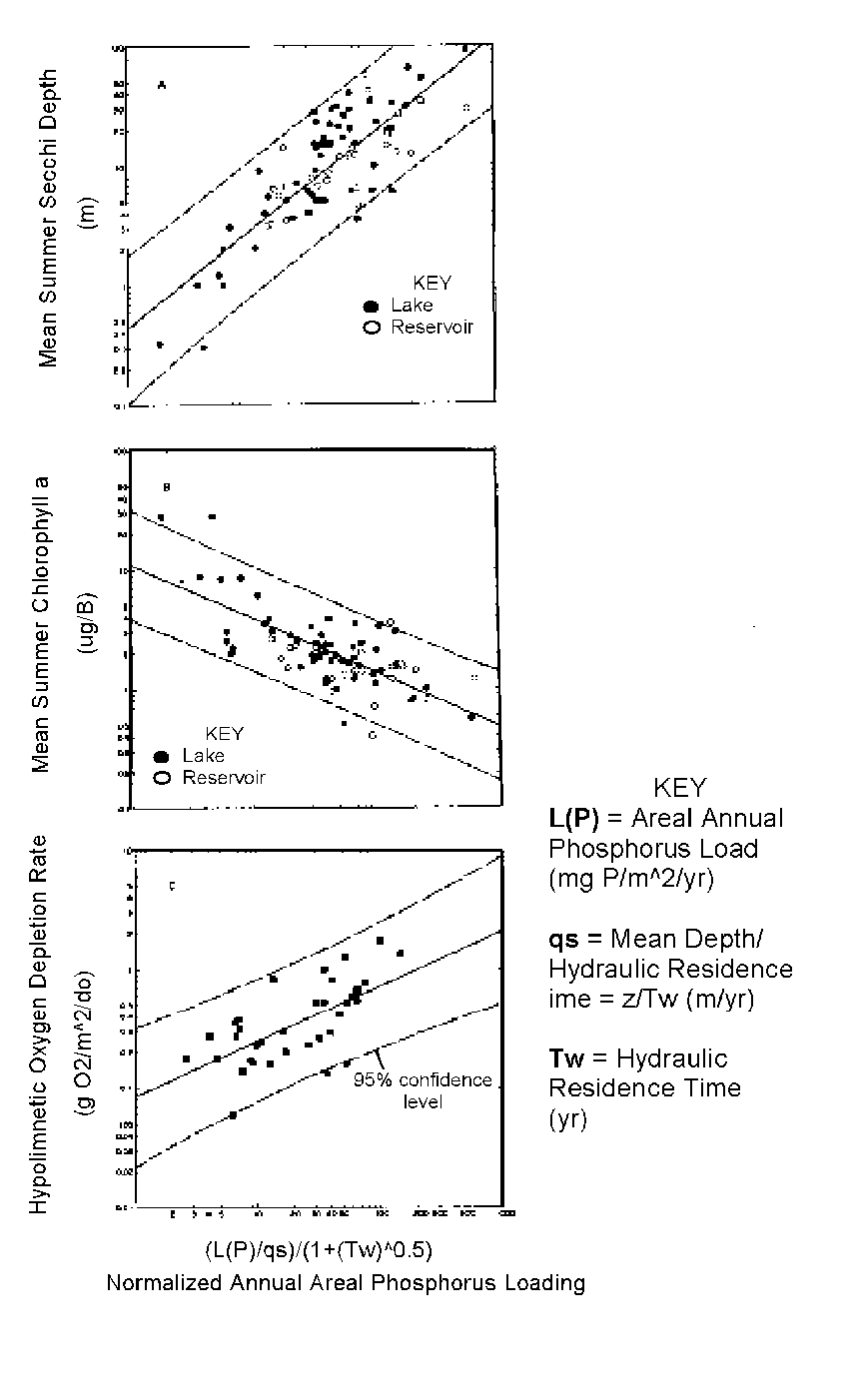
Figure 2. Updated Vollenweider-OECD Normalized P Loading--Chlorophyll Response Relationship (after Jones and Lee, 1986).
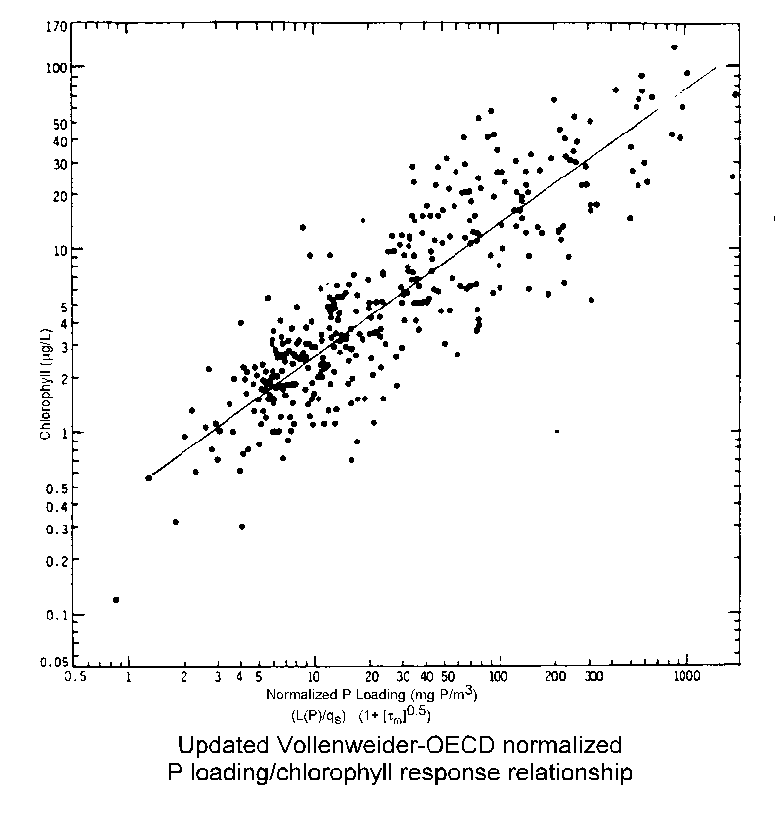
Chlorophyll-Secchi Depth Relationships
In addition to examining the relationships between normalized P load and chlorophyll, Secchi depth, and hypolimnetic oxygen depletion rate, Rast and Lee (1978) examined the overall relationship between planktonic algal chlorophyll concentrations and Secchi depth. Using US OECD eutrophication study data as well as limnological literature data on several hundred other waterbodies, they developed the statistical relationship shown in Fig. 3. It is evident from Fig. 3 that, as expected, there is an inverse logarithmic relationship between the planktonic algal chlorophyll in a waterbody and the waterbody's Secchi depth. It is also evident that there is considerable scatter about the line of best fit for the data presented in this figure. This scatter is most likely due to a number of factors, one of the most important being the presence of variable amounts of inorganic turbidity in the watercolumn that contribute to light scattering and absorption. Additionally, all of the problems associated with using chlorophyll to estimate algal biomass contribute to the scatter, such as variable amounts of chlorophyll among algal species; variable amounts of chlorophyll within an algal species as a function of cell age, nutrition, etc.; variable chlorophyll extraction efficiency as a function of cell age and solvents used; and an often overlooked factor that all measurements of chlorophyll assume that all spectrophotometers have the same molar extinction coefficient for chlorophyll. It is well known that this cannot be assumed with any degree of reliability. Considering all of these factors as well as others, it is remarkable how well the data for chlorophyll and Secchi depth correlate in Fig. 3.
The authors have found Fig. 3 to be a useful relationship for identifying those situations in which inorganic turbidity or color is a significant factor in influencing Secchi depth in a waterbody. The authors have found that waterbodies with chlorophyll-Secchi depth coordinates that fall below the scatter of points presented in this figure, tend to have high inorganic turbidity or color. Whenever Secchi depth is significantly less than that predicted based on the line of best fit in Fig. 3, the authors feel they have strong evidence for the existence of greater than normal light limitation of phytoplankton growth in a waterbody. This is a readily usable approach for determining the significance of light limitation in a waterbody. The authors have found, as a result of applying this approach to several hundred waterbodies located throughout the world, that relatively large amounts of inorganic turbidity must be present in a waterbody in order to significantly (in terms of water quality) affect the planktonic algal chlorophyll concentration of the waterbody. It has been found that, in general, inorganic turbidity-controlled Secchi depth must be a few tens of centimeters before there will be sufficient light limitation to lower phytoplankton production below that expected in waterbodies in which the Secchi depth is controlled primarily by phytoplankton. As discussed below, in addition to potentially impacting the amount of algal growth, inorganic turbidity and color are positive interferences in the measurement of planktonic algal biomass by Secchi depth.
During the 1970's, the US EPA conducted the "National Eutrophication Survey" (NES), a study of approximately 800 US lakes and reservoirs designed to determine the relationships between nutrient loads to waterbodies and the eutrophication-related water quality in these waterbodies. Based on these data, Lambou et al. (1982) presented a correlation between the chlorophyll concentrations and Secchi depths found in those waterbodies. This relationship is shown in Fig. 4 as the NES line of best fit. Also shown in this figure are the Secchi depth-chlorophyll relationships developed by Carlson (1977), and Rast and Lee (1978).
Different approaches were used in developing these three Secchi depth-chlorophyll relationships. The NES and Carlson lines were based on the data contained within their respective data sets which included waterbodies for which Secchi depth was significantly affected by color or inorganic turbidity. The NES waterbodies included a substantial number of reservoirs, which tend to have higher inorganic turbidity levels than most natural lakes. Furthermore, these waterbodies were selected to focus on excessively fertile waterbodies. The plot of these data provided by Lambou et al. (1982) shows scatter extending an order of magnitude beyond the scatter of the Rast and Lee line, and a less well-defined relationship.
The waterbodies included in the Rast and Lee regression were pre-screened to eliminate, to the extent possible, waterbodies having high levels of inorganic turbidity or color. These differences among databases are reflected by the differences in slope of the lines of best fit in Fig. 4. While the three regression lines shown in Fig. 4 appear in general to be quite similar, the bias of the Rast and Lee line against waterbodies having high inorganic turbidity is evident for waterbodies having chlorophyll levels greater than about 10
mg/L.Carlson, working with a limited number of waterbodies in Minnesota, developed chlorophyll-phosphorus-Secchi depth relationships; the Carlson correlation coefficients, however, are not appropriate for waterbodies located throughout the US and the world. There are several significant discrepancies between Carlson's relationships and those of the OECD eutrophication studies. For a Secchi depth of 2 m, Carlson's index predicts a surface chlorophyll of 6.4
mg/L, whereas the OECD line of best fit, which is based on several hundred waterbodies, predicts 9 mg/L chlorophyll. For a Secchi depth of 0.5 m, Carlson predicted a chlorophyll of 56 mg/L while the OECD relationship predicts a chlorophyll of 110 mg/L. Even greater discrepancies have been found to exist between the Carlson and OECD eutrophication study relationships for surface water P concentration-Secchi depth, and surface water P concentration-chlorophyll concentration relationships.Generally, the limnological literature indicates that Secchi depth is related to the depth of the photic zone; the depth at which there is 1% of the incident light (compensation depth) may be estimated as 2 to 3 times the Secchi depth. The results of the US, as well as the international OECD studies showed that a factor of 3 to 4 was generally more appropriate for relating Secchi depth to the compensation depth. The authors find that a factor of approximately 3.5 is a good, general conversion factor between these two characteristics.
Jones and Lee (1982b) discussed the use of planktonic algal chlorophyll as a domestic water supply water quality evaluation parameter. Since Secchi depth and chlorophyll are generally related in waterbodies in which Secchi depth is controlled primarily by phytoplankton, Secchi depth could also be a useful water supply water quality evaluation parameter. It is important to emphasize that waterbodies with large amounts of inorganic turbidity or color do not necessarily follow these relationships.
Fig. 5 presents an arithmetic plot of the chlorophyll-Secchi depth line of best fit shown in Fig. 3. This representation illustrates a number of factors to be considered in the use of Secchi depth as a water quality parameter. It is evident from Fig. 5 that in waters containing less than about 4
mg/L chlorophyll (oligotrophic waters), small changes in the chlorophyll concentration elicit substantial changes in Secchi depth. For example, changing the chlorophyll from 3 mg/L to 5 mg/L will change the Secchi depth from about 3.5 m to 2.5 m. At higher chlorophyll levels, e.g., above about 15 mg/L, however, the change in Secchi depth per unit change in chlorophyll is substantially less. Increasing the chlorophyll concentration from 20 to 30 mg/L will correspond to a Secchi depth change of 0.2 m. These results demonstrate that Secchi depth is a particularly sensitive water quality parameter for planktonic algal-related water clarity below approximately 10 mg/L chlorophyll, which is the concentration normally used to distinguish between oligotrophic and eutrophic waters. However, in hypereutrophic waters Secchi depth is a highly insensitive measure of changes in algal biomass. Therefore, it is suggested that Secchi depth not be relied on as a water quality parameter in waters containing more than about 20 mg/L chlorophyll a.In the limnological eutrophication literature reference is occasionally made to the "nutrient threshold" which is defined as the concentration of P in a waterbody which is sufficiently large so as to trigger massive algal blooms. Some effort has been made over the years to find this "magical" P concentration. The relationship shown in Fig. 5 can be used to provide insight into the development of an approach for the establishment of these P threshold concentrations. With respect to the public's perception of eutrophication-related water quality, the drastic decrease in water clarity as the chlorophyll increases above 3
mg/L could readily be interpreted as the crossing of a eutrophication threshold. From the relationships shown in Figs. 1 and 2 and the correlation between normalized P load and in-lake P concentrations developed by Rast et al. (1983), the corresponding P concentration for this threshold on an average summer chlorophyll basis is on the order of 5 mg P/L. It is not recommended, however, that phosphorus concentration in a waterbody be used as a water quality evaluation parameter since only part of the phosphorus added to or present within a waterbody is available to support algal growth.Figure 3. Relationship between Secchi Depth and Chlorophyll Concentration (after Rast and Lee, 1978).
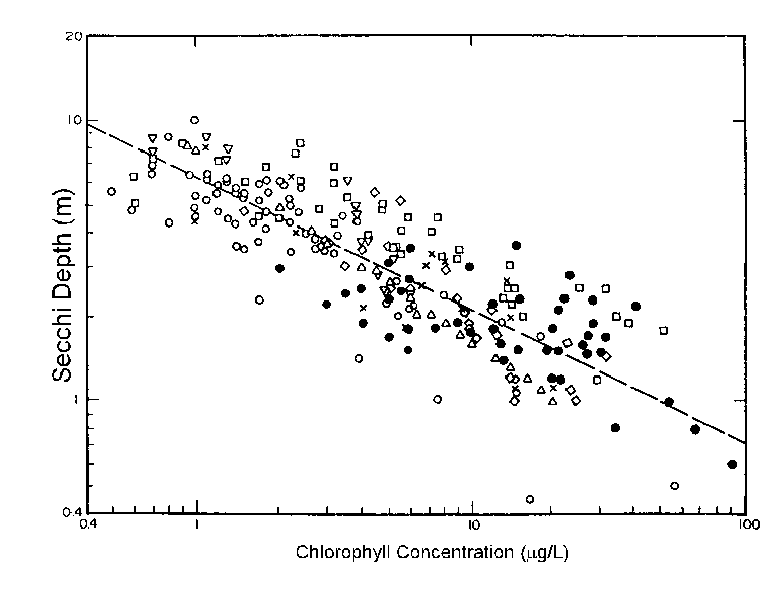
Figure 4. Relationships between Secchi Depth and Chlorophyll Concentration (after Rast and Lee, 1978).
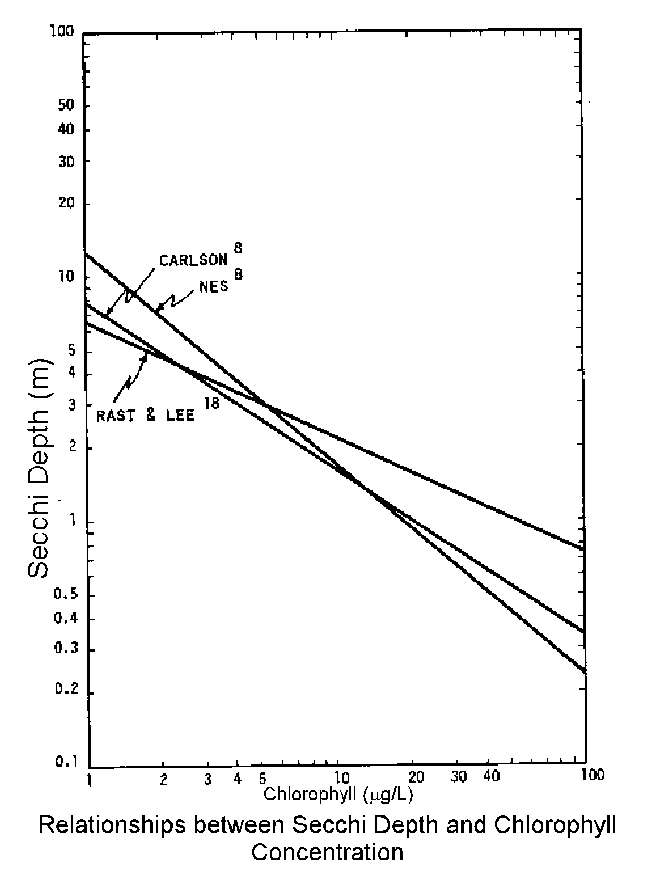
Figure 5. Linear-Scale Relationship between Secchi Depth and Chlorophyll Concentration (after Rast and Lee, 1978).
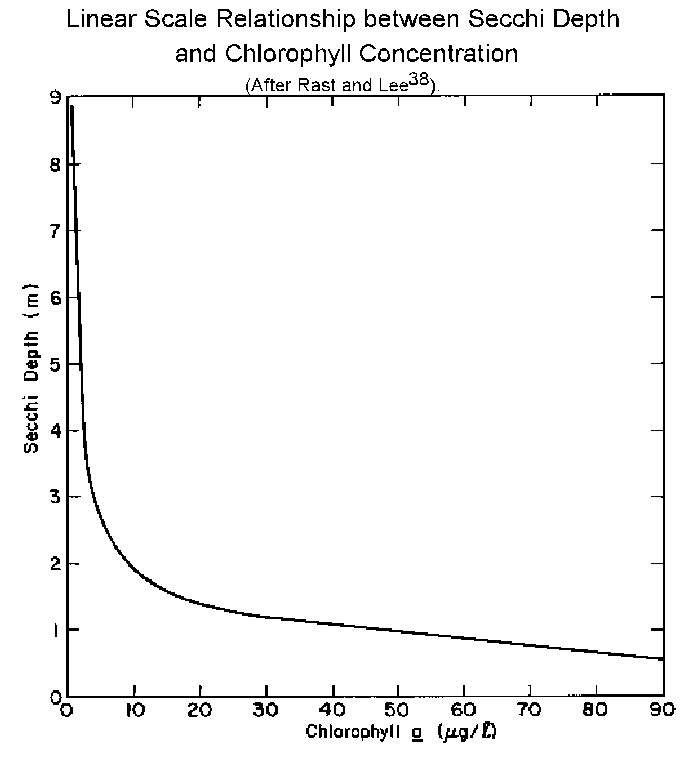
Secchi Depth - Fish Biomass Relationships
While there are a wide variety of factors that influence the numbers and types of fish present in a waterbody, the trophic status of the waterbody is one of the more important factors. There is a generally accepted progression of fish numbers and types from the relatively low numbers of highly prized fish such as salmonids in oligotrophic waters, to large biomasses of rough fish such as carp typical of hypereutrophic waters. Oglesby (1977) developed relationships between Secchi depth and fish yield and between Secchi depth and chlorophyll. Since Oglesby's database for relating Secchi depth to chlorophyll was limited compared to that developed by Rast and Lee (1978), which included over 100 data sets from the literature, Lee and Jones (1991) used Oglesby's Secchi depth-fish yield relationship in conjunction with the Rast and Lee (1978) chlorophyll-Secchi depth relationship and the Jones and Lee (1982a) P load-response relationship (Fig. 1) to develop the normalized P load-fish yield relationship shown in Fig. 6.
It is evident that with the combined use of Figs. 1 and 6, Secchi depth can be used to estimate fish yield in waterbodies having chlorophyll-Secchi depth relationships close to the line of best fit shown in Fig. 3. Further, as discussed by Lee and Jones (1991), it is possible to estimate not only fish yield but also, to some extent, dominant types of fish, considering such factors as hypolimnetic oxygen depletion rates and the development of stunted fish populations.
Secchi Depth - Trophic State Relationships
While Secchi depth is normally included in most trophic state classification systems, it was not until the work of Carlson (1977) that Secchi depth was used as one of the primary indicators of eutrophication-related water quality. It is generally the parameter to which the public can best relate. Indeed, as noted by Edmondson (1980), "Anything that affects turbidity will affect the transparency, but in many situations long term changes in transparency are generated by changes in the abundance of phytoplankton brought about by eutrophication." Goldman (1988) has also used transparency to assess the eutrophication-related water quality of ultra-oligotrophic Lake Tahoe. Goldman et al. (1983) suggested that, "A simple straight line projection of the current, highly significant trend of reduced transparency means that Tahoe, without a drastic reduction in the nutrient loading that supports algal growth, will have lost most of its transparency in only forty more years!" (emphasis theirs). At this time, Goldman (1992) has found that Lake Tahoe is losing Secchi depth transparency at the rate of about one ft/yr. Lee and Jones-Lee (1994) have discussed the importance of atmospheric sources of nitrogen (nitrate and ammonia) as the primary cause of the increased algal growth that has occurred in Lake Tahoe, which in turn is causing the rapid decrease in Secchi depth that has been observed by Goldman over the years.
As noted earlier, a basic problem with the use of Secchi depth is that while Secchi depth is always an indicator of water clarity, it is not always an indicator of trophic state, as in those waterbodies in which the water clarity is controlled by inorganic turbidity or color. It is for this reason that many of the multi-parameter trophic state classification systems that include Secchi depth are invalid (see discussion by Lee and Jones-Lee, 1995). Obviously if a parameter of the classification system such as Secchi depth can be significantly changed, for example through increasing inorganic turbidity without a concomitant change in the trophic state (algal growth) of the waterbody, then the classification system has little utility in ranking the trophic states of waterbodies. However, the public usually does not distinguish between "muddy" waters (inorganic turbidity) and "pea-soup green" (algae-laden) waters because it is usually the clarity of the watercolumn, independent of the reason for the decreased clarity, that is of concern; the exception to this is for blue-green algae that tend to form algal scums which accumulate along the shoreline. This phenomenon is generally readily associated with algae.
Several years ago a series of comments appeared in the literature addressing Carlson's (1977) use of Secchi depth in his trophic state index. The authors have addressed their findings on the utility of Carlson's index system elsewhere (see Lee and Jones-Lee 1995) but feel that the Secchi depth-chlorophyll-turbidity discussion precipitated by Carlson's paper is not directly pertinent to the utility of Secchi depth as a water quality evaluation parameter as described herein. Lorenzen (1980) and Megard et al. (1980) were critical of Carlson because he expressed Secchi depth only as a function of chlorophyll. It appears to the authors that for the purposes of "trophic state" evaluation this would be appropriate, since inorganic turbidity is not directly relatable to fertility of a waterbody. Indeed, it would only be appropriate to include the inorganic turbidity component if attempts are made to predict Secchi depth in systems containing large amounts of inorganic turbidity. Lorenzen (1980) discussed the importance of the influence of factors other than algae in influencing the light extinction coefficient in determining the value obtained for Secchi depth and the apparent relationships between Secchi depth and chlorophyll. For the latter he cited the Secchi depth-chlorophyll relationship developed by Oglesby and Schaffner (1975) on the basis of several years' data on several waterbodies, suggesting that it could be an artifact of the particular value(s) of the extinction coefficient. While his criticism undoubtedly has some merit, especially in the context of the limited number of waterbodies being represented, its significance diminishes when viewed in light of the fact that the chlorophyll-Secchi depth relationship described by Oglesby and Schaffner (as cited in Lorenzen) is essentially identical to that described by Rast and Lee (1978). Indeed, one of the waterbodies upon which Oglesby and Schaffner drew heavily for describing the relationship (Lake Washington) was not included in the Rast and Lee plot.
Again it is stressed that the authors are advocating the use of Secchi depth as an easily measured integrator of a variety of water quality characteristics in terms the public can in general understand. They do not advocate its use blindly or mechanically or without proper regard for the characteristics such as inorganic turbidity, morphology, hydrology, etc., of the particular system under evaluation as discussed elsewhere herein. In their system, the users of a waterbody would specify the desired use of the waterbody and values for associated water quality response characteristics, such as chlorophyll concentration, Secchi depth, and/or hypolimnetic oxygen depletion rate, that it feels is appropriate for the waterbody. Then, through the use of the relationships shown in Fig. 1, it is possible to estimate the maximum or minimum P loads that must be attained in order to achieve the desired water quality characteristics.
Rast and Lee (1978), Rast et al. (1983), and Jones and Lee (1982a and 1986) have discussed how to estimate the changes in water quality parameters such as chlorophyll concentration, Secchi depth, or hypolimnetic oxygen depletion rate that will result from changing the P load. They have pointed out that a change in any one of these parameters should, as a first approximation, follow a trajectory through the position of the point on the P load-response diagram, parallel to the line of best fit of the US OECD eutrophication study results. Rast et al. (1983) have shown that this proposed relationship has been demonstrated for a number of waterbodies in various parts of the world for which there are before and after P load change data on the waterbodies' chlorophyll concentration, Secchi depth, and hypolimnetic oxygen depletion rate.
For waterbodies in which Secchi depth is influenced by large amounts of inorganic turbidity, the magnitude of water clarity improvement would be less than that experienced for the waterbody in which Secchi depth is controlled only by the planktonic algal chlorophyll. Similarly, however, the public would likely be less aware of increasing amounts of algal biomass because it would not dramatically decrease water clarity.
Figure 6. Relationship between Normalized P Loading and Fish Yield (after Lee and Jones, 1991).
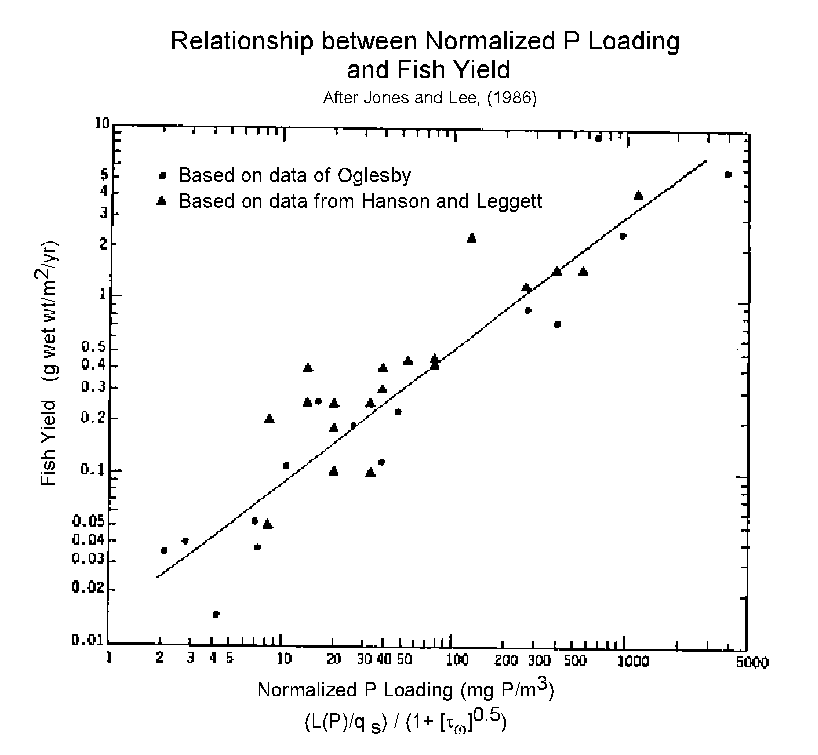
Summary and Conclusions
If properly applied Secchi depth is in general a reliable indicator of the water quality-related trophic status of the waterbody. This is especially true for waterbodies in which the Secchi depth is above approximately 1.5 m. In waterbodies in which the Secchi depth is less than about 1.5 m, the water quality-related trophic status can change significantly without substantially impacting the waterbody's water clarity. In addition to being a direct measure of water quality-water clarity, Secchi depth can, for many waterbodies, be an indirect water quality parameter of a variety of other eutrophication-related waterbody characteristics, such as chlorophyll concentration, hypolimnetic oxygen depletion rate, and fish yield. It is highly recommended that Secchi depth measurements be made in any waterbody in which eutrophication-related water quality is of concern at approximately weekly intervals over the summer growing season using a 20 cm diameter black and white quadrant disc.
References
Carlson, R. E. 1977. Trophic state index for lakes., Limnol. and Oceanogr. 22:361-369.
Edmondson, W. T. 1980. Secchi disk and chlorophyll., Limnol. and Oceanogr. 25:378-379.
Goldman, C. R. 1988. Primary productivity, nutrients, and transparency during the early onset of eutrophication in ultra-oligotrophic Lake Tahoe, California-Nevada., Limnol. and Oceanogr. 33:1321-1333.
Goldman, C. R., R. Leonard and E. Byron. May 25, 1983. Tahoe report: increasing algal growth and declining transparency., News Release. Tahoe City, 7 pp.
Goldman, C. R. 1992. Moving beyond the conflicts: research to protect lakes and reservoirs of the western states., The High Desert Museum. Bend, OR.
Hutchinson, G. E. 1975. A treatise on limnology volume 1, part I - geography and physics of lakes. Wiley-Interscience, New York.
Jones, R. A. and G. F. Lee. 1982a. Recent advances in assessing impact of phosphorus loads on eutrophication-related water quality., J. Wat. Res. 16:503-515.
Jones, R. A. and G. F. Lee. 1982b. Chlorophyll - a raw water quality parameter., J. Am. Wat. Works Assoc. 74:490-494.
Jones, R. A. and G. F. Lee. 1986. Eutrophication modeling for water quality management: an update of the Vollenweider-OECD model., World Health Organ. Wat. Qual. Bull. 11(2):67-74, 118.
Jones, R. A., W. Rast and G. F. Lee. 1979. Relationship between mean and maximum chlorophyll a concentrations in lakes., Environ. Sci. and Tech. 13:869-870.
Lambou, V. W., S. C. Hern, W. D. Taylor and L. R. Williams. 1982. Chlorophyll, phosphorus, Secchi disk, and trophic state., Wat. Resour. Bull., Am. Wat. Resour. Assoc. 18:807-813.
Lee, G. F. and R. A. Jones. 1991. Effects of eutrophication on fisheries, 5:287-305. In Reviews in Aquatic Sciences. CRC Press, Boca Raton, FL.
Lee, G. F. and A. Jones-Lee. 1994. Evaluation and management of non-point source pollutants in the Lake Tahoe watershed., P. 516-523. Proc. of the 1994 Nat. Conf. on Environ. Engin. Critical Issues in Water and Wastewater Treatment. Am. Soc. of Civil Engin., New York, NY.
Lee, G. F. and A. Jones-Lee. 1995. Alternative approaches for trophic state classification for water quality management part I: suitability of existing trophic state classification systems. Submitted for publication.
Lee, G. F., R. A. Jones and B. W. Newbry. 1982. Water quality standards and water quality., J. Wat. Poll. Contr. Fed. 54:1131-1138.
Lee, G. F., W. Rast and R. A. Jones. 1978. Eutrophication of waterbodies: insights for an age-old problem., Environ. Sci. and Tech. 12:900-908.
Lorenzen, M. W. 1980. Use of chlorophyll-Secchi disk relationships., Limnol. and Oceanogr. 25:371-372.
Megard, R. 0., J. C. Settles, H. A. Boyer and W. S. Combs. 1980. Light, secchi disks, and trophic states., Limnol. and Oceanogr. 25:373-377.
OECD. 1982. Eutrophication of Waters. Monitoring, Assessment and Control., Final Report of the OECD Cooperative Programme on Monitoring of Inland Waters (Eutrophication Control), Organ. for Econom. Cooper. and Devel., Paris, (97 82 03 1).
Oglesby, R. T. 1977. Relationships of fish yield to lake phytoplankton standing crop, production, and morphoedaphic factors., J. of Fisheries Res. Board of Canada. 34:2271-2279.
Oglesby, R. T. and W. R. Schaffner. 1975. "The response of lakes to phosphorus, P. 23-57. In K. S. Porter (eds). Nitrogen and Phosphorus--Food Production, Waste and the Environment, Ann Arbor Science, Ann Arbor, MI.
Rast, W. and G. F. Lee. 1978. Summary analysis of the North American (US Portion) OECD eutrophication project: nutrient loading-lake response relationships and trophic state indices., EPA 600/3-78-008, US EPA, Corvallis, OR.
Rast, W., R. A. Jones and G. F. Lee. 1983. Predictive capability of US OECD phosphorus loading-eutrophication response models., J. Wat. Poll. Contr. Fed. 55:990-1003.
Vollenweider, R. A. 1976. Advances in defining critical loading levels for phosphorus in lake eutrophication., Mem. 1st. Ital. Idrobiol. 33:53-83.

Reference as: "Lee, G. F., A. Jones-Lee, W. Rast, 'Secci Depth as a Water Quality Parameter,' Report of G. Fred Lee & Associates, El Macero, CA (1995)."

|
|